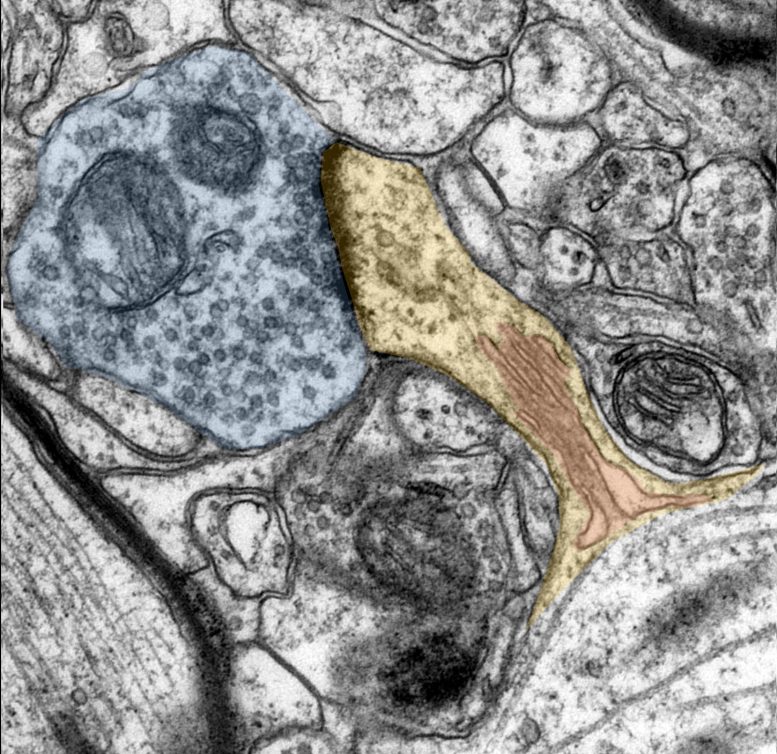[ad_1]

Using electron microscopy photos, the researchers visualize the dendritic spines (yellow) with their backbone equipment (purple) and the synapse terminal buttons (blue). Credit: Andreas Vlachos
Freiburg researchers show structural and practical plasticity in human synapses.
Neuroscientists agree {that a} person’s mind is consistently altering, rewiring itself, and adapting to environmental stimuli. This is how people study new issues and create reminiscences. This adaptability and malleability is known as plasticity.
“Physicians have long suspected that remodeling processes also take place in humans at the contact points between nerve cells, i.e. directly at the synapses. Until now, however, such a coordinated adaptation of structure and function could only be demonstrated in animal experiments,” says Prof. Dr. Andreas Vlachos from the Institute of Anatomy and Cell Biology on the University of Freiburg.
But now Vlachos, along with Prof. Dr. Jürgen Beck, head of the Department of Neurosurgery on the University Medical Center Freiburg, has offered experimental proof for synaptic plasticity in people. In addition to Vlachos and Beck, the analysis group consists of Dr. Maximilian Lenz, Pia Kruse and Amelie Eichler from the University of Freiburg, Dr. Jakob Strähle from the University Medical Center Freiburg and colleagues from Goethe University Frankfurt. The outcomes had been offered in the scientific journal eLife.
In the experiments, the group investigated whether or not so-called dendritic spines change when uncovered to a vitamin A by-product known as retionic acid. Dendritic spines are the elements of the synapse that obtain, course of and transmit alerts throughout communication between neurons. As such, they play a vital position in mind plasticity and are consistently adapting to on a regular basis expertise. For instance, studying can change the quantity and form of dendritic spines. However, a metamorphosis in the quantity or form of the spines can also be discovered in ailments resembling depression or dementia.
The analysis reveals that retinoic acid not solely will increase the scale of dendritic spines, but in addition strengthens their potential to transmit alerts between neurons. “We have concluded from our results that retinoic acids are important messengers for synaptic plasticity in the human brain. Thus, this finding contributes to the identification of key mechanisms of synaptic plasticity in the human brain and could support the development of new therapeutic strategies for brain diseases, such as depression,” says Vlachos.
To experimentally display that synaptic plasticity additionally exists in people, the researchers use tiny samples of human cerebral cortex, which should be compulsorily eliminated throughout neurosurgical procedures for therapeutic causes. The eliminated mind tissue was then handled with retinoic acid earlier than practical and structural properties of neurons had been analyzed utilizing electrophysiological and microscopic methods.
Reference: “All-trans retinoic acid induces synaptic plasticity in human cortical neurons” by Maximilian Lenz, Pia Kruse, Amelie Eichler, Jakob Straehle, Jürgen Beck, Thomas Deller and Andreas Vlachos, 30 March 2021, eLife.
DOI: 10.7554/eLife.63026
A popular scientific summary of the outcomes can also be revealed on the eLife Journal web site.
[ad_2]